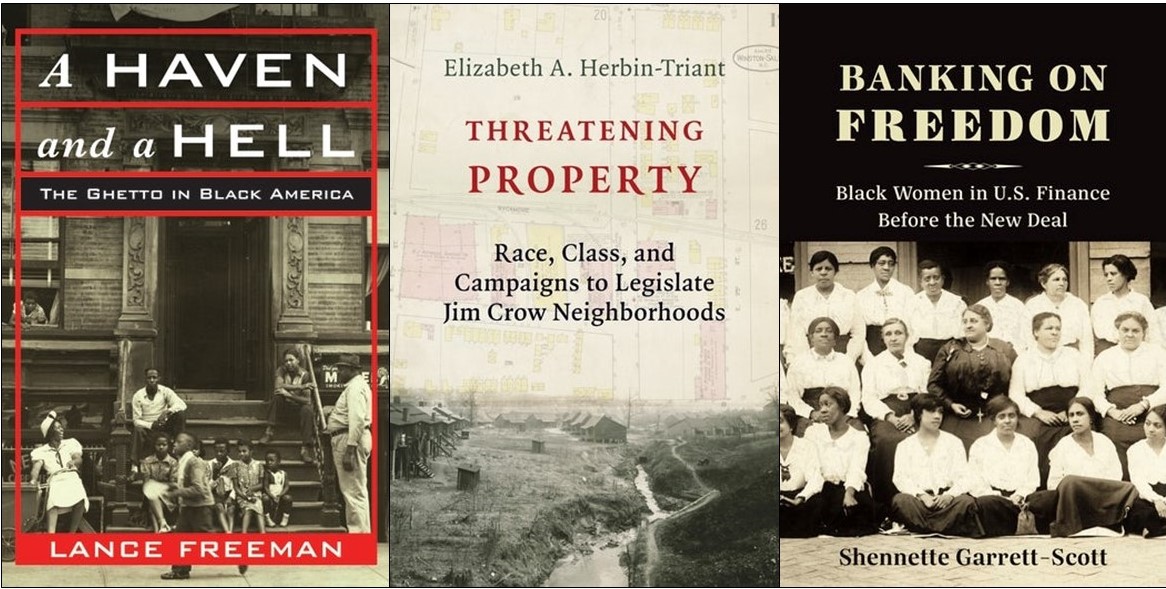Lance Freeman on the History of the Ghetto in Black America

“Ghettos, which conjure up images of abandoned buildings, crime, and decay, would hardly seem to be something to celebrate in the original spirit of Woodson’s Negro History week. But whatever the popular stereotypes, ghettos were and continue to be more than that, they were the spaces in which Black America escaped serfdom and became modern, established enduring cultural and political institutions and developed and nurtured community.”
~ Lance Freeman, professor in the Urban Planning Program in the Graduate School of Architecture, Planning, and Preservation at Columbia University. He is the author of There Goes the Hood: Views of Gentrification from the Ground Up (2005).
It’s the last day of February, and the last day of our month-long focus on Black History. We’re closing out Black History Month with this thought-provoking post from author Lance Freeman in which he discusses the portrayal of Blacks throughout history and their agency in developing the Black ghetto.
Be one of the first to own a copy of A Haven and a Hell: The Ghetto in Black America. Enter this week’s book givaway for a chance to win a copy of the book!
• • • • • •
The winner writes history, or so my father reminded me whenever we debated this or that historical fact. And so it has been with the Black experience. As the party on the “losing” end during much of America’s history, Blacks have often been written out of history, relegated to the background, bit players in the unfolding dramas of revolution, manifest destiny, and industrialization. Even events like the Civil War and Reconstruction, where Blacks were central to the unfolding story, their agency and role have often been distorted, ignored or confined to secondary importance.
Histories of the Black ghetto are in many ways no different. To be sure, there are some excellent histories documenting Black experiences in the first years of the 20th Century as budding black belts transformed into modern ghettos.[1] But in many histories of the ghetto, whites, through the ideology of white supremacy, public policy such as redlining, their actions including discrimination, terror and white flight, are the protagonists. As the Kerner Commission wrote about the ghetto “White institutions created it, white institutions maintain it, and white society condones it.” While it is crucial to document and remember the role of white supremacy in creating and maintaining the ghetto, such a history is incomplete.
“Blacks’ agency was, of course, necessary for the ghetto to come into being.”
The story of the ghetto cannot be told with Blacks as mere bystanders, victims of the actions of whites. Blacks’ agency was, of course, necessary for the ghetto to come into being. The beginnings of the Great Migration and the formation of the early ghettos in the second decade of the 20th century were the spatial manifestation of the New Negro. The New Negro came of age with no memory of slavery, was more militant and race-conscious, and willing to take steps to advance the race. Thus, the rise of the ghetto was not seen by Blacks themselves as something imposed on them by whites. Rather, leaving the South and carving out spaces in hostile white territories were seen as taking steps towards the uplifting of Blacks.
Black agency led not only to the arising of the ghetto in the first place, but also helped shaped the contours of the ghetto thereafter. Blacks were confined to the ghetto, but they used their resulting concentration to build cultural, economic and political institutions to advance their interests. The ghetto has thus been a haven—a place Blacks came together, provided support for one another and built enduring institutions. But the ghetto has also been a hell—a space of confinement and a place where many a dream was denied.
“Black agency led not only to the arising of the ghetto in the first place, but also helped shaped the contours of the ghetto thereafter.”
My forthcoming book, A Haven and a Hell: The Ghetto in Black America tells the story of the ghetto from perspective of Black Americans. It tells a story of spaces that Blacks fled to from the Jim Crow South, where they escaped near serfdom, encountered modernity and developed many of the modern cultural and political institutions and traditions that define black life to this day. The book also chronicles the struggles that ghettoization triggered. The way that ghettoization isolated Blacks, and prevented their inclusion in the full bounty of American prosperity. And the book chronicles the way black saw the ghetto, as a haven or a hell, and at times both.
Carter G. Woodson started Black History Month (originally Negro History Week) as a way to make the world aware of the accomplishments and achievements of Blacks so as to prove the folly of race prejudice and usher in a “… a reign of brotherhood through an appreciation of the virtues of all races, creeds and colors.”[i] Ghettos, which conjure up images of abandoned buildings, crime, and decay, would hardly seem to be something to celebrate in the original spirit of Woodson’s Negro History week. But whatever the popular stereotypes, ghettos were and continue to be more than that, they were the spaces in which Black America escaped serfdom and became modern, established enduring cultural and political institutions and developed and nurtured community. Moreover, while we no longer look to the past to justify our humanity, or our rights to full participation in the American polity as well its economic and social life, a full and complete picture of the Black experience in American is still important and consistent with Black History month. Documenting the role of the Ghetto in Black America as a Haven and a Hell does just that.
[1] Examples include Gilbert Osofsky’s Harlem: The Making of a Ghetto; Allan Spear’s Black Chicago: The Making of a Negro Ghetto, 1890-1920, and Kenneth Kusmer’s Black Cleveland: A Ghetto takes Shape, 1879-1930.
[i] Woodson, Carter G. 1926. “Negro History Week.” Journal of Negro History 47 (11):238-242. (Woodson 1926, 240)
Read an excerpt from the introduction of A Haven and a Hell: The Ghetto in Black America (below) and this previous post by Lance Freeman about the ghetto in Black America.




